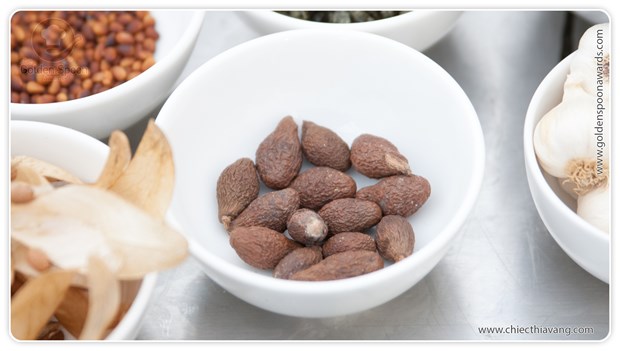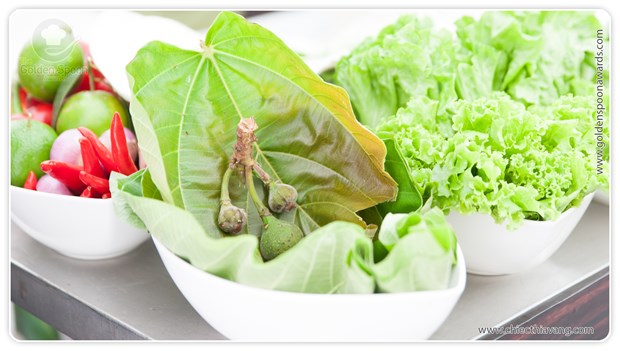A foreigner who is used to fast-food has comments
about the spices in Vietnam, but what about our chefs? Here we review the
recent, northern preliminary round of the Golden Spoon Contest, attended by
chefs from the Central region, Hanoi, the Red River Delta and the Northern
Highlands.
Long and hard journeys to search wild vegetables and
seeds
Chef Hung Cong Duong
from the Novotel Danang Premier Han River reported that it used to take him two
days and a night to travel to Cu Lao Cham in Quang Nam province to collect new
and unique spices. Actually, they are mainly wild vegetables or seeds that
provide different flavors: sour like “Bứa”
from the mangosteen family; acrid as in “mỏ
quạ” a kind of mulberry; and lightly sweet like “xứng” a type of wild vegetables. These wild vegetables and seeds
are normally to eaten as snack or main meal by for local people. Chef Hung
said,
“Before, when life was
hard and there was little to eat, local people simply ate these plants with
just fish paste. Now I want to upgrade them to become “golden dishes”.
Because there are more than a dozen new and strange spices on the table,
Chef Hung and his team had to explain to the judges, journalist and gathered
guests. “Are these malva nuts? – Yes; seeds like this are good” said Mr Sanh Ly
- Chairman of Saigon Professional Chef Association and member of judges.

Malva nuts
Because people believe
that these nuts can help to improve bones and joints, Chef Hung uses them to
make dessert in the form of a sweet soup called “Hương vị đôi môi”, this means the taste of your lips.
Judge Sang Huy Ly – Deputy of the Organizing Committee of the Golden
Spoon was excitedly waiting for the moment he could try the Golden dish from
this team: Appetizers have the taste of Cham forest, tuna sautéd and served
with boiled wild vegetables and prawn rolls with wild vegetables. “You didn’t
disappoint us. The vegetable rolls were very delicious with a special and
unique taste. It had a good balance because of the use of Sycamore seeds. If
you take these seeds, fry and crush them like peanuts and sprinkle on top of
the dish, it will improve the aroma and taste” said Mr Sang Huy Ly.
The Sycamore tree is the
symbol of the nobility, luxury and culture in the East, although the seeds are
not necessarily considered the best.
Achieving the atmosphere of mountains and jungle
The team representing the Northern Midlands was from the Flamingo Dai
Lai Tourist Resort (Vinh Phuc province) and presented “trái ngõa” fruits and leaves which were very interesting. Knowing
that “trái ngõa” belongs to the cluster fig family and
grows a lot in the forests of the
northern mountain in Vinh Phuc, Bac Giang, Thai Nguyen, Lang Son
provinces ... Its leaves are big and have a oval shape, like the leaf of
Dipterocarpaceae tree. It is slightly acrid in the taste.

Leaf and “trái ngõa” fruits (center)
According to Captain Tuan
Van Tran- local people living around Dai Lai usually use these leaves to wrap
sticky rice with ant eggs, and steam and eat fresh water fish such as like
carp. They come in three types: silver, grass and common. They mix the fish
with “thính”, a fried rice powder
which is quite complicated to cook but is very tasty.
Judges Suong Thi Bui
commented that “Trái ngõa” fruit and
its leaves are an interesting discovery. However the appetizer made with black
pomfret and “thính” rolled win the
leaves is quite salty. The table presentation was very beautiful and refined”.
There is another new
spice brought by the Sen Trang restaurant (Lao Cai province): Amaranthus. It is
a pity that it wasn’t included in the list of ingredients that was registered
for the competition by the team. Chef Nguyen Bien Cuong said that this is a
common vegetable that grows a lot in his hometown. Its color is similar to the
roselle leaf but smaller and there aren’t any leaf shapes that resemble a crows
foot. It has a light, sour taste. There is less gum than roselle leaf and Jute.
Chef Bien Cuong confirmed that this vegetable is suitable for making catfish
salad. It can be used to replace green catfish for grilled or steamed dish.
However we think it would be wonderful to make sour fish hot pot or stir-fried
quickly then eaten with duck
Other representatives
from the Northwest Highlands such as the Red Dao restaurant or Bao Chau
Boutique Sapa were also keen to win this competition. One dish was “Thắng Cố” made by Red Dao restaurant.
This dish gathered the most unique and popular spices, such as Indian prickly
ash, Cardamom, magnolia mediocris Dandy seeds, cinnamon and star anise. Chef
also brought a spice to cook this dish, “thắng
cố” tree. Its trunk looks like chives, its root like nut grass and it has a
very good aroma. “Thắng cố” tree has
the role of connecting all the spices together. On seeing this tree in real
life, judges observed it carefully and took picture.
There is another spice
which has very strange name” “mùng tang”
– its scientific name is Alocasia odora. It will be julienned, rolled with
horse meat then grilled. It also has a special aroma.
Meanwhile the Chef from the Bao Chau Boutique Sapa brought cardamom to
the contest. It has roots and ripe fruits that were served with smoked salmon.
Their cooking station attracted many people because of the colors of many
spices such as “méo méo” leaves which
is similar to the Banyan Tree’s leaves and has a sour taste, flowers of wild
dragon fruits and jabutica from Sapa

Fresh Cardamom
To upgrade spices from the highlands to become a golden dish we must
mention the grilled venison with local spices of the Northwest, prepared by
Lotte Hanoi’s chefs. Chef Vu Van Thanh (captain) studied hard to catch the
secret and typical characteristics of spices from the highlands area. These
normally have key element and tastes: sour, bitter and spicy. With the seasoned
venison tenderloin, there were two that couldn’t be left out: Indian prickly
ash seeds and magnolia mediocris Dandy seeds. It is then rolled and sauteed. By
doing so the meat is firmed and keeps its round shape when cooked. This dish is
served with wild grilled bamboo (bitter taste), Sapa plum (sour taste) and
mustard greens (spicy). Besides these it also needs “chẩm chéo” – a sauce combining chili, garlic, salt, Indian prickly
ash seeds and MSG, used for all grilled dishes. This dish helped Lotte Hanoi’s
chefs win the first prize in the semi-final in the North region.
Of course there are still many interesting and impressive
spices hidden out there, all over the country. In efforts to explore and study
to upgrade Vietnamese dishes young chefs still work very hard making long
journeys to collect news spices in order to honor them as well as contributing
to the promotion of tourism cuisine at home. This is a relatively unknown and
long term effort, so all the chefs expressed their appreciation to the Golden
Spoon contest as it creates opportunities for them to share and show off their
local spices.
Tan Trung